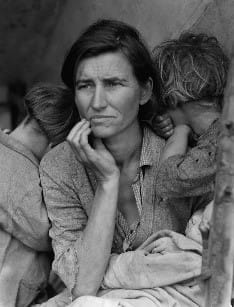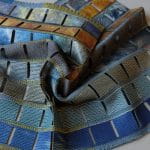Referencing images
How do I reference images?
At Norwich University of the Arts we do not apply the rules for Harvard referencing to images in the same way, as this can be difficult and confusing, especially if you are using a lot of images of your own work.
So, when you include an image in your work, you need to ensure you give it a figure number, and a caption that provides the author/creator, title and date of the work. Use italics for the title of the image only.
For example:

The first time you refer to the image in your text you should refer to the title and date, and include the figure number in brackets. This makes it clear to your reader which image you are referring to. For example:
In Migrant Mother, 1936 (Figure 1) Lange poignantly captures the desperation and despair suffered during the Great Depression.
For any further references to the image in your work you can simply use the title.
You do not need to include any details about the image in your bibliography. Citing the image as shown above is enough.
However, if you refer to any text or ideas from the same source as the image, then you would need Harvard reference this as normal.
If you haven’t referred to an image anywhere in your writing, then the image should not be included in your final submission.
How do I know the title, date and author of my image?
Title
Most works will be given a title by their creator, and this should be clear alongside the work. However, a lot of the time you may find images on the internet which may have been taken from other places, and may not have their author and title information displayed with them. In these cases it is important to make sure you try and find the original image, so you can properly credit the author. If you cannot find this, then we suggest you should not use the image. If you are using an image bank such as Pixabay the image author, date and title will always be displayed alongside the image, so it should be easy to find. If there is no title given then you may write untitled in your caption instead.
For images you have created yourself, you can create a meaningful title or add descriptive text – this may be required if you are using a film still, or a screenshot, or a photograph you have taken yourself. For example:
Nintendo, Screenshot of Link inside the Deku Tree, The Legend of Zelda: Ocarina of Time, 1998.
If you are taking a photograph of someone else’s work then you should use the title, date and author of the work you have photographed.
Author
The author is the artist/creator of the work. This may be one person, or several people. Please credit them all. If you do not know the author of the work then it is important you try and find this out. Online image banks often display the author/creator as a username e.g. Valiphotos. If you cannot find a full name then you may use the author username. However, please be careful when using social media – are you sure that the person who posted the image is the author? If you are not sure, then we suggest you should not use the image.
For screenshots or film stills, remember to use the author of the work you are representing – so for a film this would usually include the director, or for a game this would be the studio. Where no author/artist is named, use the corporate author, i.e. the organisation responsible for the resource being published. For example Tate, or BBC.
Year
The year is usually the year in which the work has been published or shown for the first time. For physical artworks this information is usually given alongside the work. For films or games this would the year of release. For photographs this will be often be the year the photo was taken, or you may have to use the date the photo was uploaded if you are using an image from the internet. If you are using an image from a book, and the image does not have an individual date, then you would use the copyright date of the book itself. For webpages try scrolling down to the bottom of the webpage to look for the copyright date for the whole site, and use this date instead. For photos you have taken of other artworks, remember to use the date of creation of the artwork you have photographed.
Make every effort to accurately date your image. For instance, if you are showing game art you can use the date of the release of the game, or for an advertising campaign you can use the date the advert was first run. If you still cannot find a date, you can use ‘no date’, but use this option with caution – do you have enough information about where it came from and who created it to accurately attribute the image in your work?
What is a table of illustrations?
The university no longer requires a table of illustrations so please follow the guidance above.
For information, a table of illustrations is a list of all the figures you have used in your work – you can find an example by looking in books that contains a lot of illustrations or colour plates.
If you have any questions just get in touch with your librarian library@norwichuni.ac.uk
